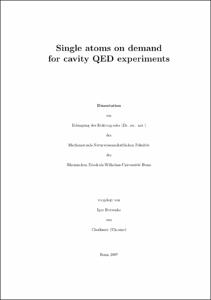Single atoms on demand for cavity QED experiments

Single atoms on demand for cavity QED experiments

| dc.contributor.advisor | Meschede, Dieter | |
| dc.contributor.author | Dotsenko, Igor | |
| dc.date.accessioned | 2020-04-10T15:19:26Z | |
| dc.date.available | 2020-04-10T15:19:26Z | |
| dc.date.issued | 2007 | |
| dc.identifier.uri | https://hdl.handle.net/20.500.11811/3091 | |
| dc.description.abstract | Cavity quantum electrodynamics (cavity QED) describes electromagnetic fields in a confined space and the radiative properties of atoms in such fields. The simplest example of such system is a single atom interacting with one mode of a high-finesse resonator. Besides observation and exploration of fundamental quantum mechanical effects, this system bears a high potential for applications quantum information science such as, e.g., quantum logic gates, quantum communication and quantum teleportation. In this thesis I present an experiment on the deterministic coupling of a single neutral atom to the mode of a high-finesse optical resonator. In Chapter 1 I describe our basic techniques for trapping and observing single cesium atoms. As a source of single atoms we use a high-gradient magneto-optical trap, which captures the atoms from background gas in a vacuum chamber and cools them down to millikelvin temperatures. The atoms are then transferred without loss into a standing-wave dipole trap, which provides a conservative potential required for experiments on atomic coherence such as quantum information processing and metrology on trapped atoms. Moreover, shifting the standing-wave pattern allows us to deterministically transport the atoms (Chapter 2). In combination with non-destructive fluorescence imaging of individual trapped atoms, this enables us to control their position with submicrometer precision over several millimeters along the dipole trap. The cavity QED system can distinctly display quantum behaviour in the so-called strong coupling regime, i.e., when the coherent atom-cavity coupling rate dominates dissipation in the system. This sets the main requirements on the resonator's properties: small mode volume and high finesse. Chapter 3 is devoted to the manufacturing, assembling, and testing of an ultra-high finesse optical Fabry-Perot resonator, stabilized to the atomic transition. In Chapter 4 I present the transportation of single atoms into the cavity and their coupling to the cavity mode. The strong coupling manifests itself in a strong reduction of the cavity transmission probed by a weak external laser. The atoms remain trapped and coupled to the cavity mode for several seconds until we move them out of the cavity for final analysis of their number and position. | en |
| dc.language.iso | eng | |
| dc.rights | In Copyright | |
| dc.rights.uri | http://rightsstatements.org/vocab/InC/1.0/ | |
| dc.subject | Laserkühlung | |
| dc.subject | optische Atomfallen | |
| dc.subject | Dipolfallen | |
| dc.subject | Manipulation einzelner Atome | |
| dc.subject | Cavity-Quantenelektrodynamik | |
| dc.subject | Atom-Licht-Wechselwirkung | |
| dc.subject | laser cooling and trapping | |
| dc.subject | dipole traps | |
| dc.subject | manipulation of single atoms | |
| dc.subject | cavity quantum electrodynamics | |
| dc.subject | atom-photon interaction | |
| dc.subject.ddc | 530 Physik | |
| dc.title | Single atoms on demand for cavity QED experiments | |
| dc.type | Dissertation oder Habilitation | |
| dc.publisher.name | Universitäts- und Landesbibliothek Bonn | |
| dc.publisher.location | Bonn | |
| dc.rights.accessRights | openAccess | |
| dc.identifier.urn | https://nbn-resolving.org/urn:nbn:de:hbz:5N-10697 | |
| ulbbn.pubtype | Erstveröffentlichung | |
| ulbbnediss.affiliation.name | Rheinische Friedrich-Wilhelms-Universität Bonn | |
| ulbbnediss.affiliation.location | Bonn | |
| ulbbnediss.thesis.level | Dissertation | |
| ulbbnediss.dissID | 1069 | |
| ulbbnediss.date.accepted | 22.05.2007 | |
| ulbbnediss.fakultaet | Mathematisch-Naturwissenschaftliche Fakultät | |
| dc.contributor.coReferee | Yatsenko, Leonid |
Files in this item
This item appears in the following Collection(s)
-
E-Dissertationen (4400)




